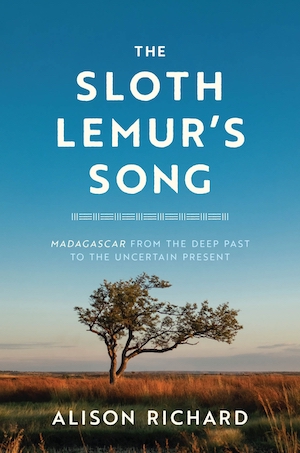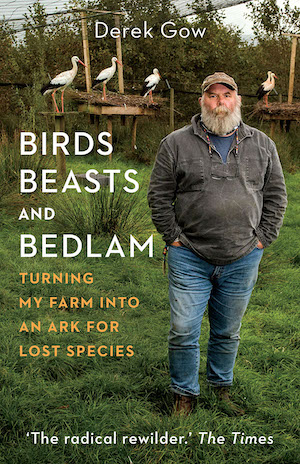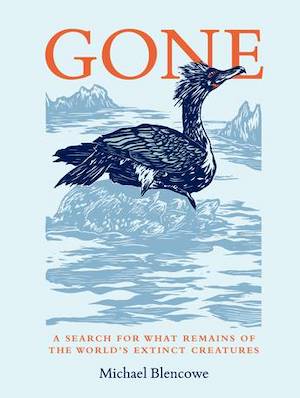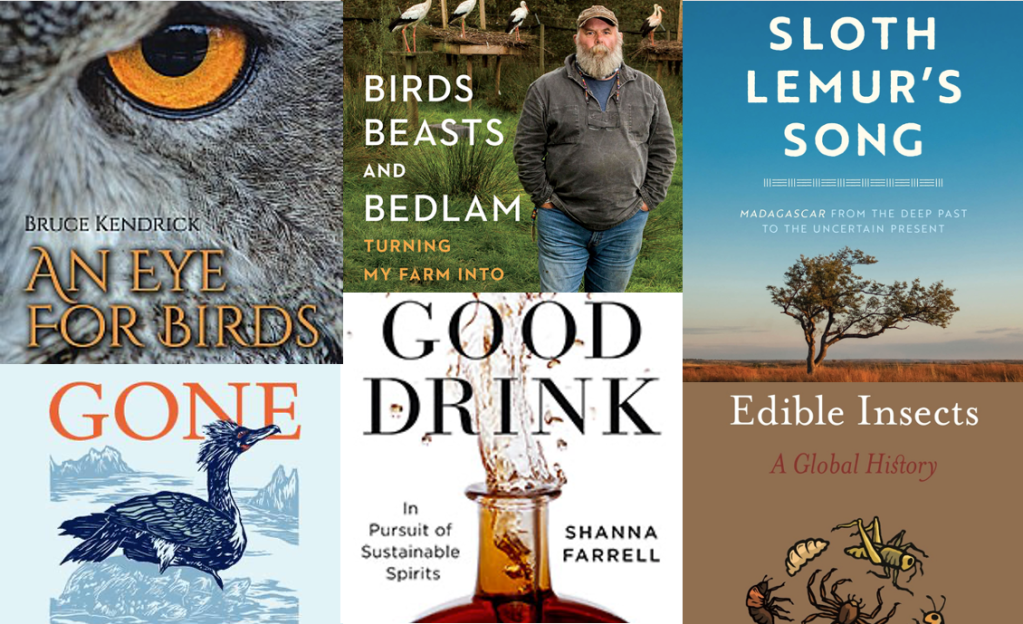Discussing books with friends and colleagues lately, I hear one sentiment frequently expressed: “I don’t want anything heavy.” Two years into a pandemic, with various bad news and personal stresses as a backdrop, perhaps you feel the same.
I do, too. Despite being a lifelong and obsessive reader, in recent months I find myself doing things like assembling intricate jigsaw puzzles and binge-watching a show about Boba Fett.
I even decided to take a break from reviewing books. Until this batch arrived. They covered topics that fascinate me: Madagascar and eating bugs and drinking and rewilding and extinct creatures.
And they’re great reads, all of them. I enjoyed each one. Reading about conservation and nature doesn’t have to feel like work. In fact, I’d argue the opposite is true. I hope you enjoy these picks for Earth Day.
-
The Sloth Lemur’s Song
By Alison Richard

My fascination with Madagascar began at an early age and has never waned, which I imagine is true for many nature-loving youth. I learned at an equally early age that people arrived on this island and immediately set about despoiling paradise, a version of history repeated so often I accepted it as truth. But reality is far more complicated, as research biologist Alison Richard demonstrates in this brilliant book.
Madagascar’s ecological history is in fact a story of dramatic change over millions of years. Colonial accounts that blamed any change on Malagasy communities were based on prejudices and Edenic myths.
This is simply a wonderful book. Richard tells Madagascar’s often improbable history with vivid detail and personal story based on her research, all backed up with the latest scientific thinking. The scope of the book reminds me of Tim Flannery’s ecological histories, which I love, and in many ways this one is even better. Whether she’s telling the improbable story of how lemurs arrived on an island, or explaining why grasslands are not necessarily a sign of deforestation, you will enjoy the stories so much you may not notice that your world is expanding. As all great books should do.
-
Birds, Beasts and Bedlam
By Derek Gow

Derek Gow hears conservationists talking about changing the world, and he has little patience for it. He’d rather be doing. This is a fun memoir by a British farmer turned rewilder. Gow grew up wanting to be a farmer, and after giving it a go, found it difficult to make a living. But he loved being on the land, and tinkering, and experimenting – all of which served him well when he began to take on wildlife rehabilitation and reintroduction projects.
Gow comes across the pages as a first-rate character, full of bristly opinions and no shortage of colorful yarns. He also no fear of failure, whether he’s raising what are likely Britain’s first free-roaming beavers in centuries or breeding wildcats.
Despite having a large human population, the United Kingdom has a lot of open space. That open space is unfortunately biologically impoverished, and the obstacles to restoring a diversity of wildlife seems daunting. But not to Derek Gow. If you doubt one person can make a difference, this is an entertaining read proving otherwise.
-
An Eye for Birds
By Bruce Kendrick

At age 10, Bruce Kendrick was diagnosed with tuberculosis and sent to an English sanatorium for six months. He was forced to remain bedridden, spending most of his time in a quiet room. One can only imagine the nightmare this was for a child, although Kendrick downplays the horror. He looked forward to his daily time outside, when he looked at birds he didn’t know.
When he mentioned this to his father, he received a bird book as a gift, launching a lifelong passion for birds and birding. After his release from the sanatorium, he found three friends who shared his fascination, and began seeking out birds around his British home.
This is not a book about birding as a hobby. Rather, it’s birding that is incorporated and integrated into every aspect of life. It’s a coming-of-age story, made more poignant as Kendrick returns to childhood haunts in later years. Interspersed are his thoughts on evolution and conservation and much more, making this a welcome addition to the library of great British birding books.
-
A Good Drink
By Shanna Farrell

There’s a well-known trend of conscientious diners demanding to know how restaurants source their food. They want to know the stories of the food, know how it was raised and understand the sustainable practices used by farmers. But Shanna Farrell noted that this accountability didn’t extend to the liquor shelves in those same restaurants.
A former bartender, Farrell wants to know what goes into a cocktail – beyond the ingredients. Producing liquor often relies on monocultures, poor labor practices, high water use and other troubling practices. And so she goes in search of a sustainable drink.
And she finds it, from a couple producing whiskey with heritage corn varieties to tequila producers dedicated to preserving the diversity of agave. Farrell is a masterful storyteller and interviewer, making this a highly readable account. And it likely will change your next trip to the liquor store.
-
Edible Insects: A Global History
By Gina Louise Hunter

Edible insects remain an important both nutritionally and culturally to millions of people around the globe. And yet many Western societies view eating insects as, at best, a source of extreme amusement on reality television.
This compact volume, part of Reaktion Books’ excellent Edible series, provides the perfect primer on the many facets of edible insects. It includes hunting and harvesting practices, insect agriculture, cultural practices and taboos and potential future scenarios. It’s a nice overview, and includes great photos and illustrations as well as some recipes.
Many recent media on edible insects offer them as some kind of utopian wonder food, a carbon friendly source of protein. I especially appreciate Hunter’s balanced take on this topic. It is true that rearing insects typically requires less land and less resources than other animal protein. Still, barriers are significant, and there’s a lack of science on the impacts of scaling up.
-
Gone
By Michael Blencowe

Another fascination of mine as a child naturalist was extinct creatures. How I wished I could encounter them. The photos of taxidermied specimens captured my imagination in ways difficult to describe. And I now have a kindred spirit in Michael Blencowe.
Like me, Blencowe was fascinated and haunted by extinct beasts, often lingering over them in museums. In this book, he looks for what remains – the museum specimens and stories – of 11 creatures no longer on this planet.
Blencowe contemplates the often-troubling legacy of the naturalists, explorers and hunters who collected the specimens now found in museums. He handles museum specimens and talks to those who remain passionate about these creatures. And he heads afield to spots where these animals once lived.
It’s illustrated with lovely prints by Jade They, making this feel like a natural history book of my youth. I devoured this book in one sitting. I can’t recommend it highly enough.




Join the Discussion